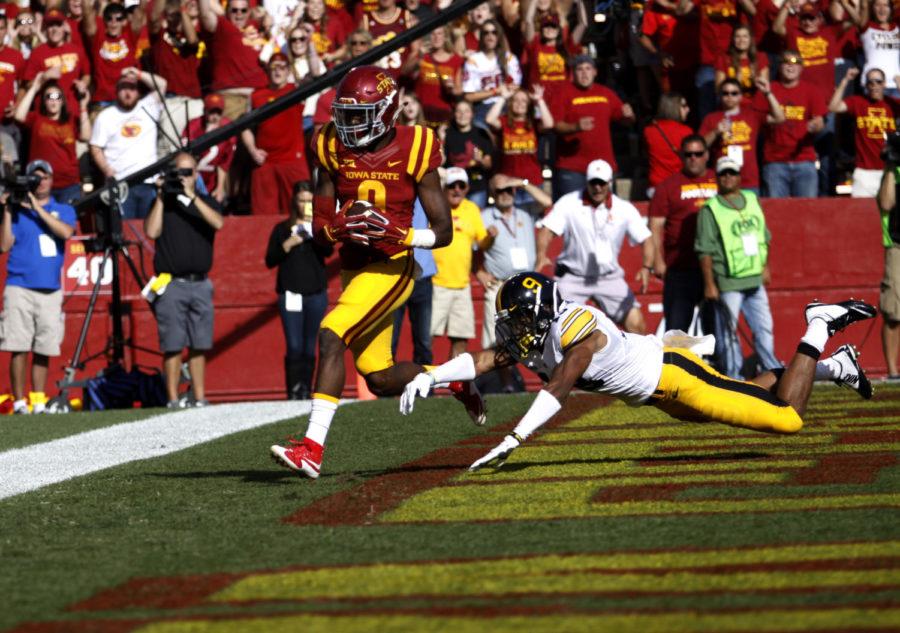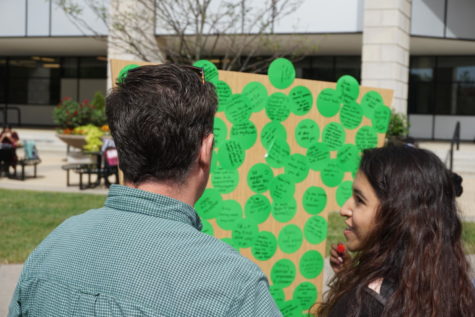Consequences be damned, ISU football MUST assume risk to beat TCU
October 16, 2015
The position of the ISU football team after five weeks is perhaps best described by one of The Door’s most infamous lyrics.
“The time to hesitate is through.”
Iowa State (2-3, 1-1 Big 12) welcomes undefeated Texas Christian on Saturday, and the only chance the Cyclones have against Heisman candidate Trevone Boykin and the No. 3 Horned Frogs is to play the gambler.
The Cyclones’ hopes of keeping pace with an offensive attack that averages 51 points and 615.5 yards per game reside in their ability to channel their inner-Doug Flutie and throw a series of proverbial Hail Mary’s — closing their eyes, crossing their fingers and hoping for the best.
That doesn’t mean quarterback Sam Richardson needs to look for 50-plus-yard completions every play for touchdowns, although one or two of those completions would go a long way toward Iowa State’s cause. But ISU coach Paul Rhoads agrees that against a team like TCU there can be no great rewards absent great risks.
“You’re always looking for shots, every opponent you face, you’re looking for your windows of opportunity,” Rhoads said. “You know you’ve got to create some breaks if you’re going to pull something off against a team like this.”
There were several instances in Iowa State’s 66-31 defeat at Texas Tech last weekend in which the team operated counterintuitively to that strategy. The most prevalent was perhaps when the Cyclones opted for a field goal on 4th and goal from the 3-yard line while trailing by 17 points in the middle of the third quarter.
The move made two conflicting statements. The first was that the ISU coaching staff accepted the reality of a three-score game, took the points necessary to make it a two-score game and trusted its team’s ability to position itself for a comeback.
The second was that the coaches didn’t trust the ISU players enough to gain the three crucial yards that could have applied some pressure to the Red Raiders down the stretch.
Against the third-highest scoring offense in the land, Iowa State must go for broke any time its within sniffing distance of six points, let alone on the edge of the goal line. But scoring quickly, utilizing the deep pass and capitalizing on explosive plays will prove just as important in a game that will likely require six or seven ISU touchdowns if the Cyclones are to hold out any hopes of victory.
“It’s that feel for a game, when a team is vulnerable and when potentially it can happen,” Rhoads said. “It’s through setting it up, running this and running that and maybe getting a team little bit overextended for some things. Then having the opportunity and [knowing] that you’ve got them set up.”
Momentum-shifting, game-altering plays won’t only be the responsibility of the offense, though. The defense needs to lend more of a helping hand this time out, a fact of which the ISU defenders are painfully aware.
“We’ve just got to play harder,” said ISU linebacker Jordan Harris. “We’ve got to play way harder than we played down in Lubbock.”
They need to play smarter, too, and recognize the situation — a criticism that extends from the players on the field to the coaching staff on the sideline.
ISU defensive coordinator Wally Burnham took exception this past week to criticism of his newly implemented 3-4 system in the wake of the disheartening loss to Texas Tech, inviting reporters to head on up to his office and draw up a game plan if they could “come up with something better.”
Burnham wasn’t wrong when he implied that even in a room full of media who “know so much about football,” he’s still the most qualified to set up a defensive scheme and implement a game plan. But that doesn’t mean external criticism was unwarranted or incorrect when administered on a play-by-play basis.
For instance, Iowa State trailed Texas Tech 24-14 nearing the midway point of the second quarter when 20 penalty yards and an incomplete pass set the Red Raiders in a 3rd-down-and-30 from their own 18-yard line, the definition of an unmanageable down and distance.
The most typical school of thought in such circumstances is to run a draw or a screen pass underneath a backed-up defense, pick up 10 or 15 yards — if you’re lucky — and punt the ball away with better field position.
Texas Tech took another approach.
TTU quarterback Patrick Mahomes received the snap, and eight ISU defenders dropped back into coverage. The three-man ISU rush applied zero pressure on Mahomes, who drifted, watching the play develop. He connected at the TTU 49-yard-line with Ja’Deion High for a back-breaking 31-yard gain and a first down.
Two plays and a 49-yard-touchdown pass later, the Red Raiders had robbed the Cyclones’ of their chance to climb back into the game, extending the lead back out to 17 points.
Eight defenders should be able to protect a 30-yard cushion, but a little pressure on the quarterback might have made all the difference on that play. Burnham traded the dynamic potential of a pass rush for the conservative approach — a move meant to eliminate the worst-case scenario, which instead led to it.
Despite the deflating nature of that play and the limitations of conservative decision making, Harris said the players have the utmost faith in Burnham.
“I trust [Burnham]. All of us trust [him], he’s been doing it too long,” Harris said. “He knows what’s going on, he knows everything, so you’ve got to go with what he says.”
Texas Tech was the first air raid offense Iowa State has faced this season and a prototype of the sort of attack that Burnham’s 3-4 defense was meant to combat. In its debut performance, Iowa State’s 3-4 setup was lacking.
But if Harris is right in his assessment of his coach, then Burnham — along with Rhoads and ISU offensive coordinator Mark Mangino — will know that Saturday is a day to pull out all the stops.
Whether that means blitzing in third-and-long situations, playing backup quarterback Joel Lanning more or taking downfield shots on trick plays, the ISU coaching staff has to mix it up. They have to take chances. They have to light a fire, not just by capitalizing on opportunities that present themselves, but taking risks to create those opportunities.
The time to hesitate is through.

















